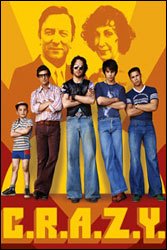 I saw a former Oscar-nominated director and a potential nominee last night. Ironically, I've seen neither of their current movies.
I saw a former Oscar-nominated director and a potential nominee last night. Ironically, I've seen neither of their current movies.We were at the Pop Culture as History/History as Pop Culture panel, part of the Toronto Film Festival's Canada's Top 10 screenings. The panelists: director Atom Egoyan whose most recent film Where The Truth Lies screened at Cannes and TIFF (he was an Oscar nominee The Sweet Hereafter), and Jean-Marc Vallée, the director of C.R.A.Z.Y., Canada's official submission for this year's best foreign-film Oscar. We're off to see Where The Truth Lies tonight and are going to try and catch C.R.A.Z.Y. at one of the city's rep theatres on Sunday.
It was my first time going to the Top 10 series after years of attending the film festival. It took place at the Art Gallery of Ontario and was such an intimate setting that I felt part of the conversation between the filmmakers and the moderator. It was a good thing they took questions, as I was ready to interject. I guess that's what you get for sitting in the second row.
For both of these directors, pop culture sets the mood and tells parts of the story without words. In Vallée's case, music informed who his main character was and his relationship with his father. In Egoyan's film the pop culture was viewed as the cage that the performers were caught in. I can't wait to see their full films (we saw clips) and see how they used it.
What I really found fascinating was their discussion of rights and licensing. If a director wants to use a song, a poster, an album cover or a TV clip, they have to pay and pay handsomely. Vallée said he paid $112,000 to use a couple of minutes to use the Rolling Stone's Sympathy for the Devil. It's a small fortune, but he felt like he needed that particular song to complete his scene. Egoyan said he once used the Santana song Oyo Como Va and paid $5,000. He used it again in Where the Truth Lies and it cost $50,000, just because Santana’s profile is higher.
And those were the songs they could get the rights for. Egoyan said he had to digitally erase the cover of David Bowie’s Diamond Dogs album from a scene and Vallée said he had to replace a Joy Division song with The Cure’s 10:15 On A Saturday Night because he couldn’t get permission. (Geek side note: I have the same imported vinyl edition of The Cure’s first album that he was talking about.)
We all connect certain songs to moments in our life and if we were to make a film we would probably want the exact perfect song to bring it back to life. Which is why I find it so perplexing that artists (and more likely labels) make it so difficult and expensive for anyone else to use their music, especially as it will likely mean more sales for them.










No comments:
Post a Comment